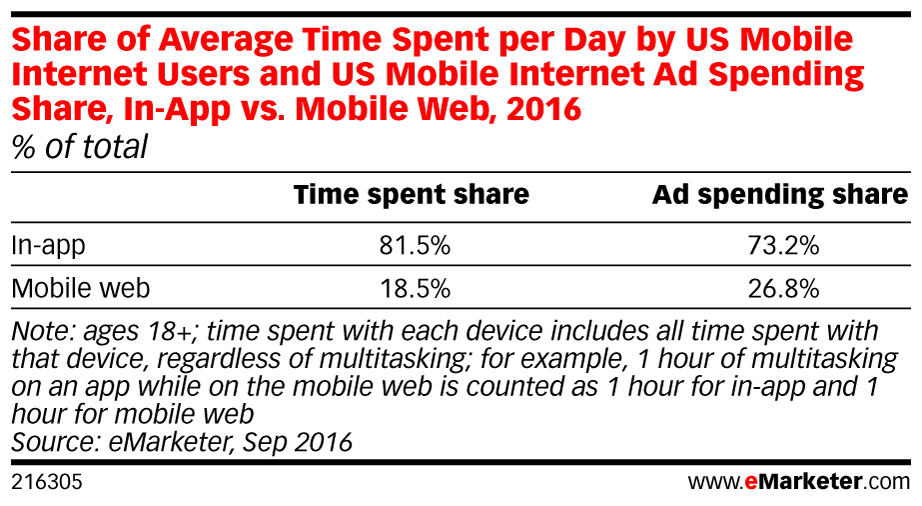As consumers spend an ever increasing amount of time on mobile, so it is becoming all the more important for brands to optimize their campaigns on the medium. In this pursuit, there are several considerations for brands seeking to captivate consumers on mobile.
Balancing In-App & Mobile Web
Unfortunately, many advertisers are over-spending on mobile web advertisements relative to the time users actually spend on these properties.

Currently, only 18.5% of mobile time spent is on mobile web, yet mobile web claims 26.8% of mobile ad spend. Meanwhile, 81.5% of time spent on mobile is spent in-app, yet in-app advertising accounts for only 73.2% of ad spending share.
As such, it would behoove advertisers to rethink their media mix to more closely align consumer content consumption behaviors.
Addressing Viewability
Another area of concern for brands advertising on mobile is the viewability of their ads. After all, what good is a paid impression that isn’t truly seen? It’s no wonder that 91% of digital ad professionals working at publishers cite viewability as a moderate to extreme concern.

In the same vein, it’s not surprising that 79% of advertisers are concerned about ad blocking. After all, ad block usage is projected to double in the next few years, with potential display ad revenue loss expected to crest over $12 billion.

So what can a brand do to ensure their ads are seen, and not scrolled past before it loads, is in focus, or is caught by an ad blocker? There are several options available, including:
- Change the bid. Bid based on actions (CPA) instead of impressions (CPM), thereby ensuring the brand never pays for an impression that wasn’t seen.
- Go in-app. Place mobile campaigns exclusively within apps, which are free from the ad blocking vulnerabilities of mobile web.
- Get verification. Bid through a tracking & attribution company that has verifiable standards for viewability.
- Go full-screen. Consider premium, full-screen interstitial ad placements in lieu of cheaper & more easily ignored banners.
Optimizing Creative
Finally, brands must consider optimizing their creative for mobile environments. After all, what captivates on a television or desktop may fall flat when shown on a 4″ screen, and 79% of mobile users will reject content that’s not optimized for their device.
So what can a brand do to optimize their creative for mobile? While there are countless best practices that vary by campaign objectives, there are numerous baseline considerations, including:
- Leverage non-standard times. Just because a television spot is typically produced in 15 second intervals does not mean that a mobile video ad needs to follow the same timeline. In fact, it’s been shown that performance campaigns perform the best when they are 23 to 29 seconds in duration.
- Use close shots & quick cuts. A comScore study has shown that in-feed ad units that offer product closeups & snappy cuts between a handful of scenes are the most captivating for distracted mobile audiences.
- Don’t rely on audio. Many mobile users have their phones silenced, so ad creative that relies on an audible narrative may fall flat. Consider subtitles and key text callouts to tell the story.
- Shake things up. Haptic feedback can be integrated into mobile ad creative to create more immersive experiences.
Summary
In short, if brands want to optimize their campaigns and truly captivate users on mobile, they must rethink their budgets, their placements, and their creative. Anything less is a waste of money, time, and consumer patience. Anyone who has ever quickly closed out of an ill-designed ad on their phone knows this to be true.

5 Responses to Captivating on Mobile: Considerations for Brands